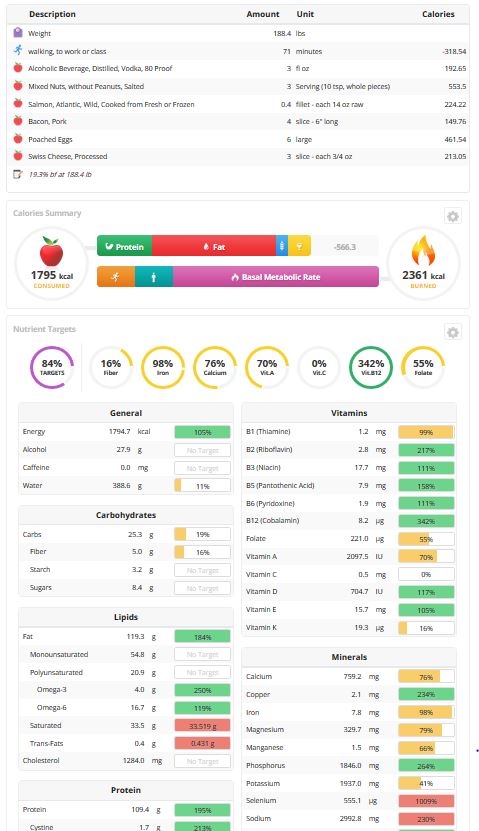Losing Weight Sustainably: New Habit One--Tracking
Tracking Your Weight, Calories, and Caloric Expenditure
The way you get less heavy is by changing the habits of what you shove into
your mouth. My kryptonite has always been Fritos and pizza. And potato chips. I
was never so much of a sweets addict, but I certainly appreciate a piece of
chocolate cake or the odd chocolate milkshake. Oh, and onion rings. Because I
deserve them!
So we get to habit number one that you need to modify. This is
crucial, and if you don’t establish it, you will fail. I promise.
1. You can’t fix what you can’t see: you need
to scrupulously track your weight and your intake every day. Not once a week,
not neurotically twice a day or more, but once a day in the morning, preferably
after you’ve taken a dump.
· Cronometer.com
provides a free online weight/calorie/nutrition module that you can access from
anywhere that is connected to the Internet. Sign up for it.
I usually set up my meals the day before. If you have a relatively repetitious diet, you can copy one day to another all at once.
Cronometer provides, in its profile section, a projection of when you will get to a target
you can set and change. I only found this app when I had lost about 15 pounds
over three months, flying blind (because I really didn’t want the bother or the
accountability of tracking this stuff, even though it’s easy once you start).
Do yourself a favor, and use this from the beginning. You get a pretty graph of
your progress (very encouraging, or else cautionary if you begin to wander
off), and you get to see exactly what that piece of Domino’s deluxe feast pizza
holds. It's highlighted below, and you can see it comprised 410 of my 1770 kcal that day. One slice. And 47 g of carbohydrate, all by its lonesome!
If at some point you find during the day that you just had to have that piece of chocolate, or that extra drink with your best friend down at the Legion, that’s fine, but you must log it. You must log it. You cannot fix what you cannot see. And if you want to lie to yourself in the privacy of your own Cronometer program, well . . . that’s what got you fat, in large part (as it were) right? Don’t do it. Who the hell are you trying to impress?
· Get a real scale. You don’t need one that
also purports to measure your body fat (I have recommendation for that later,
too, but for now, yeah, you know you’re fatter than you want to be).
The real scale will give you the data to enter into the Cronometer
app. Get a cheap, highly reviewed one from Amazon, no bells and whistles, just
the weight facts, please, ma’am. You’ll be able to see whether you’re losing
(Yay!) or plateauing. You’ll be able to see the cost of those onion rings or second slice of pizza, because your weight loss will
probably get less impressive for a day or two. And you might hiccup up a pound or two.
You will not lose weight every day (see glycogen/evacuation notes
below), but you will see your progress. Even without deviating from your
personal plan, the body takes a while to adjust its weight, so don’t be pussy,
and hang in there. Look at my graph above: see the plateau periods? But just as
water wears away stone, if you do keep on keepin’ on, down you’ll go.
Eventually you’ll come to have faith in this. Yes, you have to consume fewer calories than you burn each day, but that can be painless. We'll get into that later.
The virtue of pre-weighing evacuation of the body is self-evident.
You should weigh yourself at the same time every morning, preferably right when
you wake up, when you will likely be at your lowest weight of the day. You’ll
be drinking lots of water during the day to keep your weight-loss machinery
well oiled (more on that later in the What to Eat post), and consistency is a
virtue when you’re trying to measure one variable over time. Confounding
variables are an enemy of good scientific inquiry.
As for glycogen, it’s how your readily available carbohydrate is
stored. You have some stored up in your muscles, about 2500 kcal worth stored
in the liver, conjugated with water. So that first four pounds that often
vanishes when you first have a few days with a negative calorie balance? That’s actually your
stored carbohydrate, glycogen conjugated with water (about 4 lb worth).
The bad news is that you pizza/nacho yourself, boom, back on it comes,
and that’s not encouraging. The very good news is that once you are
carbohydrate/glycogen depleted, you can start to more selectively burn your own
fat. And, once you get used to burning fat, your body and brain quite prefer
that food source.
We’ll get into that next time.



Comments
Post a Comment